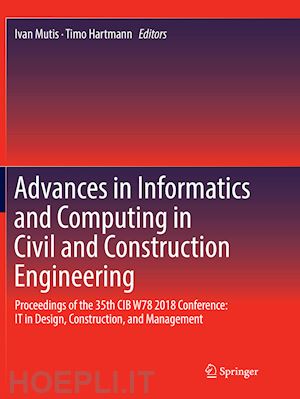
Questo prodotto usufruisce delle SPEDIZIONI GRATIS
selezionando l'opzione Corriere Veloce in fase di ordine.
Pagabile anche con Carta della cultura giovani e del merito, 18App Bonus Cultura e Carta del Docente
This proceedings volume chronicles the papers presented at the 35th CIB W78 2018 Conference: IT in Design, Construction, and Management, held in Chicago, IL, USA, in October 2018. The theme of the conference focused on fostering, encouraging, and promoting research and development in the application of integrated information technology (IT) throughout the life-cycle of the design, construction, and occupancy of buildings and related facilities. The CIB – International Council for Research and Innovation in Building Construction – was established in 1953 as an association whose objectives were to stimulate and facilitate international cooperation and information exchange between governmental research institutes in the building and construction sector, with an emphasis on those institutes engaged in technical fields of research. The conference brought together more than 200 scholars from 40 countries, who presented the innovative concepts and methods featured in this collection of papers.
Dr. Ivan Mutis is an Assistant Professor, Department of Civil, Architectural and Environmental Engineering, Illinois Institute of Technology, Chicago, IL. Throughout his active research career, Dr. Mutis has worked at the nexus of new technologies, cognition, and construction, pioneering the integration of intelligent systems into civil and architectural engineering applications. His studies have been recognized as innovative, transformative and of national significance by agencies including National Science Foundation. Professor Mutis received his Ph.D. from the University of Florida.
Dr. Timo Hartmann is Professor for Systems Engineering at the TU Berlin. In his research and practical work, he develops state of the art system visualization and simulation technologies and integrates these technologies with the working processes of construction, engineering, and architectural professionals. Professor Hartmann received his Ph.D. from Stanford University where he was a student at the Center for Integrated Facility Management. He is also deputy editor of Construction, Engineering, and Architectural Management and Advanced Engineering Informatics.











Il sito utilizza cookie ed altri strumenti di tracciamento che raccolgono informazioni dal dispositivo dell’utente. Oltre ai cookie tecnici ed analitici aggregati, strettamente necessari per il funzionamento di questo sito web, previo consenso dell’utente possono essere installati cookie di profilazione e marketing e cookie dei social media. Cliccando su “Accetto tutti i cookie” saranno attivate tutte le categorie di cookie. Per accettare solo deterninate categorie di cookie, cliccare invece su “Impostazioni cookie”. Chiudendo il banner o continuando a navigare saranno installati solo cookie tecnici. Per maggiori dettagli, consultare la Cookie Policy.